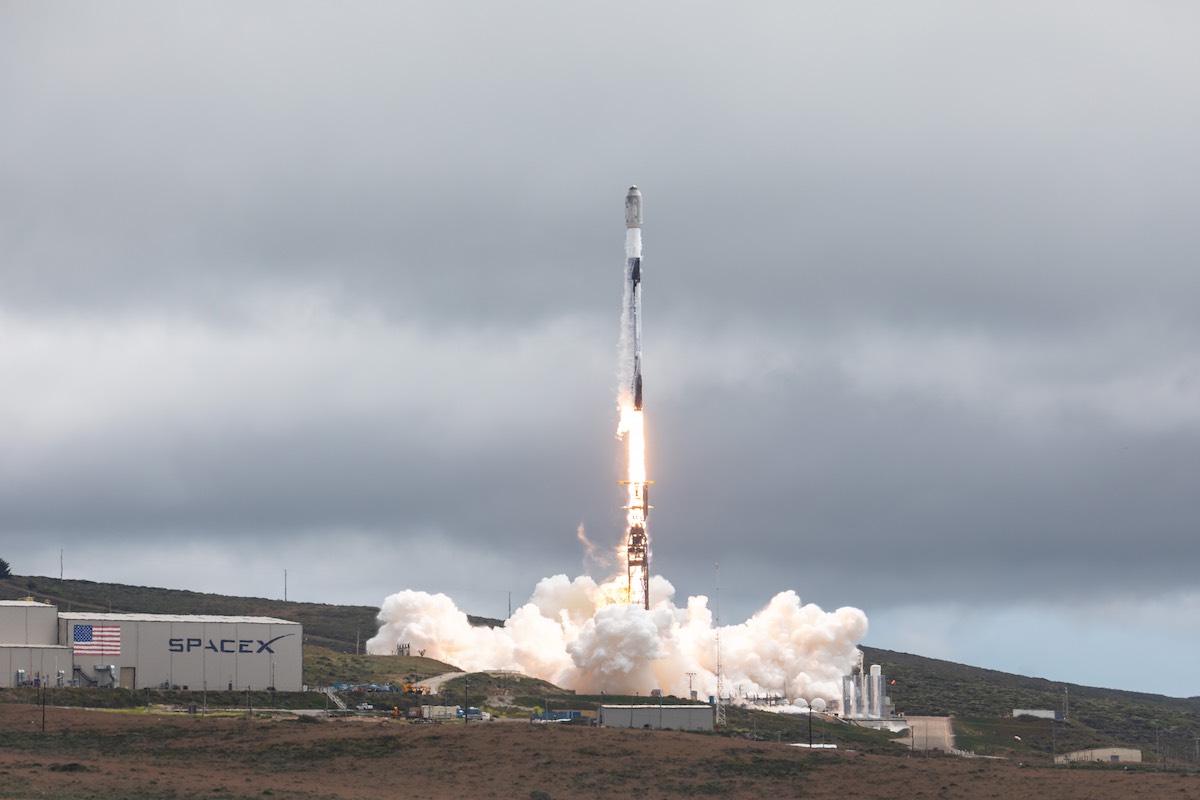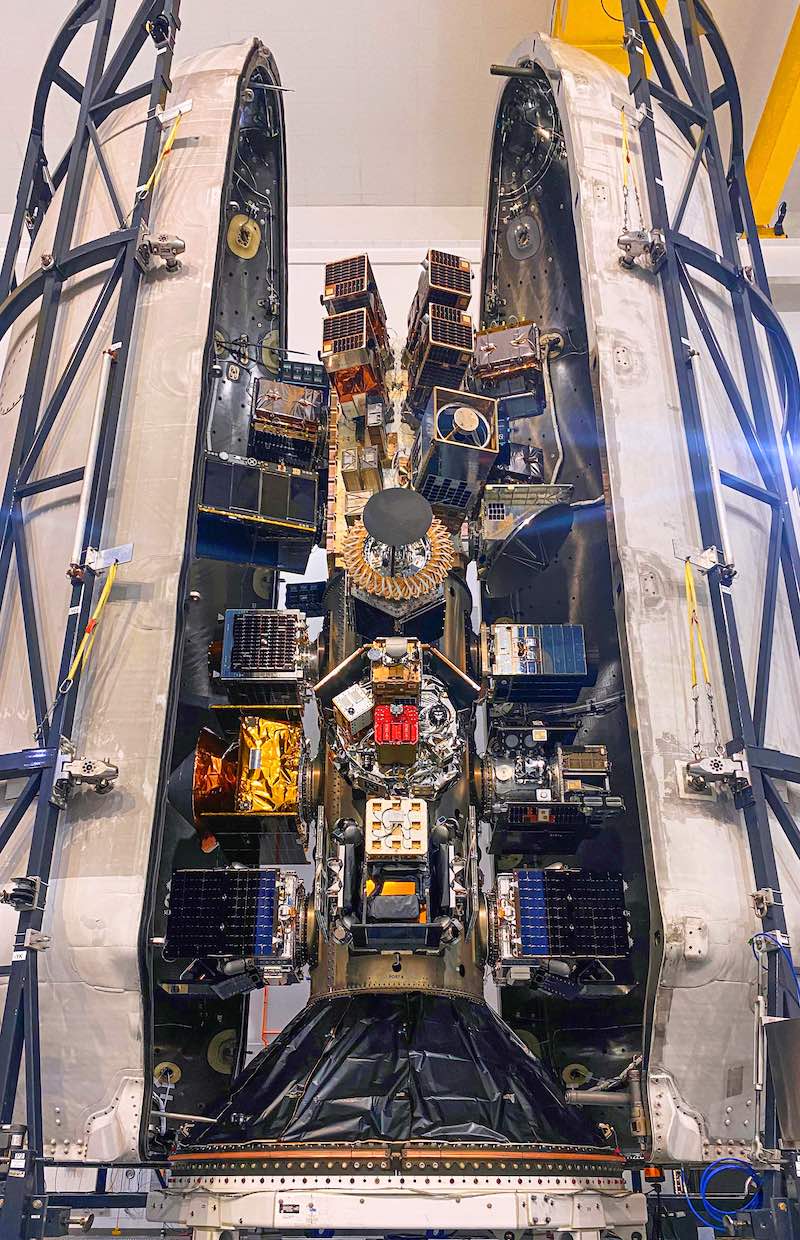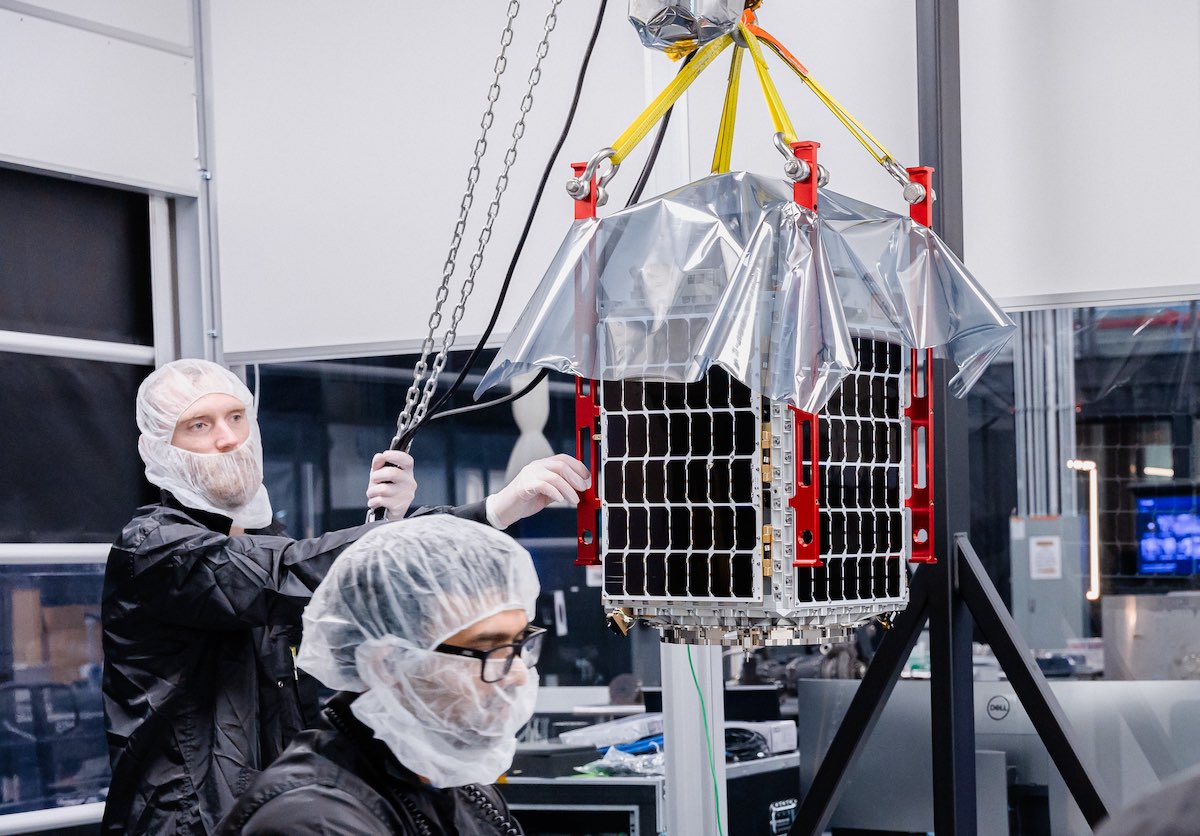Space News & Blog Articles
SpaceX nails 200th rocket landing after launch with 72 small satellites
 SpaceX’s Falcon 9 rocket lifts off Monday on the Transporter 8 mission. Credit: SpaceX
SpaceX’s Falcon 9 rocket lifts off Monday on the Transporter 8 mission. Credit: SpaceX
SpaceX launched 72 small payloads into polar orbit from California’s Central Coast Monday, delivering satellites to space for customers around the world while accomplishing the 200th landing of a Falcon rocket since the first booster recovery in 2015.
A Falcon 9 rocket lifted off on SpaceX’s Transporter 8 rideshare mission at 2:35 p.m. PDT (5:35 p.m. EDT; 2135 UTC) Monday from Space Launch Complex 4-East at Vandenberg Space Force Base, California, a military facility about 140 miles (225 kilometers) northwest of Los Angeles.
The Falcon 9 vaulted through scattered clouds, and its nine kerosene-fueled engines powered the launcher through the atmosphere before shutting down more than two minutes into the mission. The first stage of the rocket detached and pulsed cold gas thrusters to flip into a tail-first orientation, then reignited three of its engines to boost itself back toward Vandenberg.
The 15-story-tall booster reignited its center engine in the final seconds before touchdown on Landing Zone 1 at Vandenberg, completing the rocket’s ninth trip to space. The booster’s return to Vandenberg marked the 200th time SpaceX has landed a Falcon rocket intact, and the 126th successful Falcon landing in as many attempts.
It was the 41st SpaceX launch of the year, and the 232nd flight of a Falcon 9 rocket since 2010.
SpaceX’s first successful booster landing in December 2015 opened a new era in rocketry. The company has now flown some of its boosters as many as 15 times, with plans to certify rockets for up to 20 flights in the coming months.
On Monday’s mission, the Falcon 9 rocket’s upper stage fired its single engine two times to reach a near-circular polar orbit about 325 miles (525 kilometers) above Earth. Then the Falcon 9 started deploying its payloads over the course of the next half-hour.
The satellites aboard SpaceX’s Transporter 8 mission ranged in size from a loaf of bread to a refrigerator. The satellites will test new technologies for the U.S. military and international companies, collect weather data, and observe the Earth’s surface in high resolution.
 The 72 payloads for SpaceX’s Transporter 8 mission before encapsulation inside the Falcon 9 rocket’s payload fairing. Credit: SpaceX
The 72 payloads for SpaceX’s Transporter 8 mission before encapsulation inside the Falcon 9 rocket’s payload fairing. Credit: SpaceX
One of the Transporter 8 payloads is from Varda Space Industries, a California-based startup planning a series of satellite missions to host microgravity experiments from pharmaceutical companies. Varda’s first space mission is among the 72 payloads buttoned up for launch today from California.
Varda’s 660-pound (300-kilogram) satellite is the first in what the company calls its Winnebago series. The idea is that a small re-entry capsule, about 3 feet (1 meter) in diameter, will bring pharmaceutical research specimens back to Earth for laboratory analysis, and potentially eventual commercial exploitation.
Astronauts perform similar research on the International Space Station, but there’s a long waiting list for experiments to fly to the space station. And perhaps more importantly, there’s a limited capacity to return cargo from the station to Earth, a capability almost exclusively provided by SpaceX resupply missions flying to and from the orbiting research lab about three times per year.
Founded in 2020 by two venture capitalists and a former SpaceX engineer, Varda wants to help move some pharmaceutical research off the space station. The company’s missions will be hosted on robotic spacecraft, the first four of which are built by Rocket Lab.
Previous research has shown some drugs are better produced without influence from Earth’s gravity. Varda’s first mission will focus on growing crystals associated with ritonavir, an antiviral ingredient in the COVID medication Paxlovid, and also used in treatment of HIV.
Rocket Lab’s Photon satellite platform will provide power, communications, propulsion, and attitude control for Varda’s re-entry capsule. At the end of the mission, likely some time in July, the Photon satellite platform will fire its engine to steer on a trajectory back into Earth’s atmosphere. The nearly 200-pound re-entry capsule will fall through the atmosphere, encountering temperatures of thousands of degrees while protected by an ablative carbon-based heat shield developed by NASA.
The capsule will deploy a parachute to slow for landing at the U.S. Air Force’s Utah Test and Training Range, where Varda specialists will be on-hand to recover the spacecraft.
Other payloads on the Transporter 8 mission include space tugs, or orbital transfer vehicles, from the U.S. company Launcher and the Italian space transportation provider D-Orbit. Each transfer vehicle has its own propulsion, and will deploy additional satellites over the coming weeks and months.
One of the satellites on Launcher’s transfer vehicle is from a Seattle area startup named Starfish Space. The company’s first satellite will attempt to perform the first rendezvous and docking in orbit using only electric propulsion. Electric propulsion uses ion thrusters, which are highly fuel-efficient but low-thrust, typically fired for large-scale orbit change maneuvers or on interplanetary voyages.
Spacecraft that need to connect with another object orbit have previously used higher-thrust liquid-fueled rocket engines, which are suited for quick course-correction maneuvers as one satellite moves in for docking with another one.
“People have been docking objects in space for almost 60 years now,” said Austin Link, co-founder of Starfish Space, and a former engineer at Blue Origin. “The problem is that, to date, all satellite dockings have cost hundreds of millions of dollars to get to that point, and these are large and complex spacecrafts with really long development timelines and really expensive development timelines.”
Aside from crew and supply spacecraft that regularly dock at the International Space Station, Northrop Grumman has developed satellite life extension vehicle to autonomously link up with aging satellites in geostationary orbit. And DARPA, the military’s research and development agency, demonstrated automated docking in low Earth orbit on its Orbital Express mission launched in 2007.
Link said ambitions to operationalize satellite servicing and space debris removal require a significant reduction in costs.
Starfish hopes their first demonstration mission, called Otter Pup, will prove out technologies that could be applied to future satellite servicing or space debris removal missions that could be flown at a lower cost than existing spacecraft.
“This is a 40 kilogram (88-pound) satellite that we’re going to have tried to go dock with another satellite,” Link said. “And if we’re successful, this will be the first ever commercial satellite docking in low Earth orbit. It’ll be the first ever satellite docking using electric propulsion, and we will have just docked a satellite for less than $10 million total cost, which is about 5% the cost of any previous satellite docking mission … If we’re successful, yes, it opens up the business case for us to do satellite life extension and space debris removal.”
Some time in the coming weeks, Starfish’s Otter Pup satellite will separate from Launcher’s orbital transfer vehicle, which will also deploy several other customer satellites. After a series of checkouts and tests, Otter Pup will re-approach the orbital transfer vehicle and attempt to dock.
“This will be over the course of a few months,” Link said. “We’re going to separate from them, drift several kilometers apart, and attempt to come back together and dock with their satellite.”
Otter Pup’s xenon-fueled electric propulsion system was supplied by Exotrail, and the satellite carries an electrostatic capture mechanism from Redwire to structurally link up with Launcher’s orbital transfer vehicle to complete the docking sequence.
The spacecraft itself was built by Astro Digital, and will use a binocular computer vision system to feed range, closure, and position data into Otter Pup’s autonomous guidance computer to oversee the rendezvous and docking.
Link and Trevor Bennett, another veteran of Blue Origin, founded Starfish Space in 2019.
“We are developing the Otter, which is a satellite servicing vehicle designed to grab and move other satellites in space,” Link said. “We focus on using this to extend the life of geostationary satellites, and also dispose of dead satellites in low Earth orbit. And the Otter Pup is really the key technology demonstration vehicle to make this possible.”
According to Link, Starfish has raised more than $20 million in venture capital funding, and has contracts with NASA and the U.S. military. The company currently has a staff of about 40 full-time employees.
“We’re still in the early stages, and it comes with a lot of uncertainty,” Like told Spaceflight Now in an interview. “Otter Pup could go up there and dock and open up the Otter and this brilliant future, or it could not dock, and then we try again.”
 Starfish Space’s Otter Pup spacecraft during integration with Launcher’s orbital transfer vehicle. Credit: Starfish Space
Starfish Space’s Otter Pup spacecraft during integration with Launcher’s orbital transfer vehicle. Credit: Starfish Space
Also on-board the Transporter 8 mission were three small experimental U.S. military satellites to test communications technology. Two of the satellites are part of the military’s Modular Intelligence, Surveillance, and Reconnaissance, or MISR, mission to demonstrate two-way communications with devices on the ground. Another satellite, named XVI, will use the military’s encrypted Link 16 network to test communications with tactical-level military forces on the ground. The XVI experiment is a joint effort between the Air Force Research Laboratory and Viasat.
The Finnish company Iceye launched four new radar imaging satellites on the Transporter 8 mission. The satellites, each with a mass of less than 200 pounds (about 85 kilograms), are part of Iceye’s latest generation of Earth observation spacecraft, with the ability to image Earth’s land and water surfaces night and day in all weather conditions.
The new-generation Ice satellites have a resolution of about 20 inches, or 50 centimeters, allowing the company to debut a new image product it calls “Spot Fine.” Iceye as now launched 27 radar imaging spacecraft, and plans to add four more to its commercial Earth-imaging fleet later this year.
“Spot Fine means what it says. Customers can understand their areas of interest with finer detail and therefore extract better, more reliable, more actionable information about what is happening on the ground,” said John Cartwright, head of data products at Iceye. “SAR (synthetic aperture radar) imagery enables precise detections of objects and features on the ground. With Spot Fine, the shape, structure, and even changes in these objects and features can be more easily identified and characterized.”
Satellogic, the Argentine remote sensing company, launched four high-resolution optical Earth-imaging satellites on the Transporter 8 mission, bringing its fleet to 38 microsatellites. Satellogic aims to field a fleet of 200 optical Earth-imaging satellites in the coming years.
This email address is being protected from spambots. You need JavaScript enabled to view it. the author.
Follow Stephen Clark on Twitter: @StephenClark1.
When you subscribe to the SpaceZE News Feed, we will send you an e-mail when there are new updates on the site so you wouldn't miss them.

